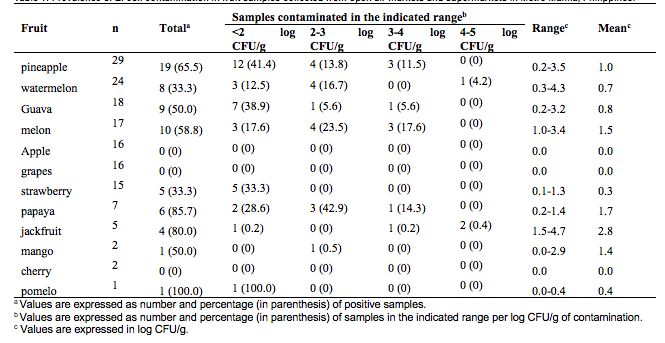VOLUME 11 (Supplement)

Philipp. Sci. Lett. 2018 11 (Supplement) 037-042
available online: July 13, 2018
*Corresponding author
Email Address: pierangeli.vital@upd.edu.ph
Date Received: January 20, 2018
Date Revised: April 26, 2018
Date Accepted: April 27, 2018
ARTICLE
Bacteriological screening of fresh and fresh-cut fruits vended in select open air markets and supermarkets in Metro Manila, Philippines
by Adrienne Cornelia Marie Therese A. Mathay1, Ma. Angela Z. Dimasupil1, Windell L. Rivera1,2 and Pierangeli G. Vital1,2,*
1Institute of Biology, College of Science, University of the Philippines Diliman,
Quezon City 1101, Philippines
2Natural Sciences Research Institute, University of the Philippines Diliman,
Quezon City 1101, Philippines
Quezon City 1101, Philippines
2Natural Sciences Research Institute, University of the Philippines Diliman,
Quezon City 1101, Philippines
The recent increase in the consumption of fresh produce may be associated with risk of infection caused by microorganisms. Microbial contamination of produce may occur in different stages of the supply chain including plant cultivation, harvest, transportation, and processing. In developing countries, outbreaks linked to fresh produce consumption are not well-documented and limited data are available regarding the microbiological quality and safety of crops. In this study, microbial contamination in different types of fruits collected from select local markets in Metro Manila, Philippines was evaluated. The scope of this study is limited to screening of microbial contamination of fruits at the end of the food supply chain, where products are ready for purchase and consumption. Traditional culture methods were used to detect and quantify thermotolerant Escherichia coli and Salmonella spp. Polymerase chain reaction was utilized to confirm the identity of E. coli isolates. Out of 152 samples, 63 (41.5%) were positive for E. coli with a mean count of 0.8 log CFU/g. The highest E. coli count in individual samples was observed in a peeled jackfruit sample (4.7 log CFU/g). Among fruit types, the highest mean E. coli count (2.8 log CFU/g) was observed in jackfruit samples. Salmonella was not detected in any of the samples. Its presence, however, cannot be completely ruled out due to the method utilized. The commercial source of the fruits, be it supermarkets or open air markets, did not appear to affect the observed E. coli counts. The study does not intend to identify the source in which contamination occurred, however, this finding suggests that the common origin of contamination of produce might have occurred in the earlier stages of the supply chain. It was also interesting to note that slicing, peeling, and other processing methods may have had an effect on the incidence of contamination of samples by E. coli due to the differing mean count patterns observed between whole and pre-sliced fruits. The prevalence of E. coli found in markets in the study could serve as persuasive reinforcement of the need to implement stronger hygienic handling, processing standards, and produce quality monitoring in the country.
© 2025 SciEnggJ
Philippine-American Academy of Science and Engineering